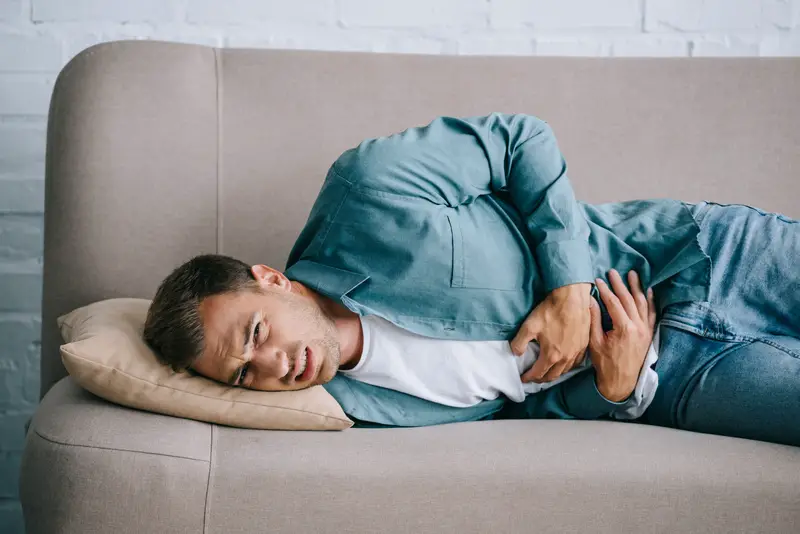What Is IBS?
IBS is an acronym that stands for Irritable bowel syndrome. It is a lifelong problem that affects the digestive system. This functional gastrointestinal disorder has no exact cause. Instead, it is characterized by symptoms such as recurrent abdominal pain, abdominal discomfort, and abnormal bowel habits such as diarrhea and constipation.
A recent research explaining TCM for IBS classified IBS into four main types. They are IBS-D, which is a diarrhea-predominant kind of IBS; IBS-C, constipation-predominant IBS; IBS-M, a mixed kind of IBS; and: IBS-U, an unclassified IBS. This research explains that IBS has a prevalence of about 5% to 22% in various countries, with Asian countries between the range of 2.9% and 15.6% and China between 0.82% and 11.5%.
Despite this classification of IBS, Traditional Chinese Medicine mostly classifies IBS as “abdominal pain,” “Xiexie,” and “Yuzheng.” The cause of which include abnormal emotions, diet, external evil, liver depression and spleen deficiency, spleen and liver yang, cold, and heat. Western medicine has no cure for IBS; therefore, acupressure for IBS is one of the most effective treatments for IBS, especially as it is affordable, highly effective, and has few adverse effects.
Can Acupuncture Help IBS?
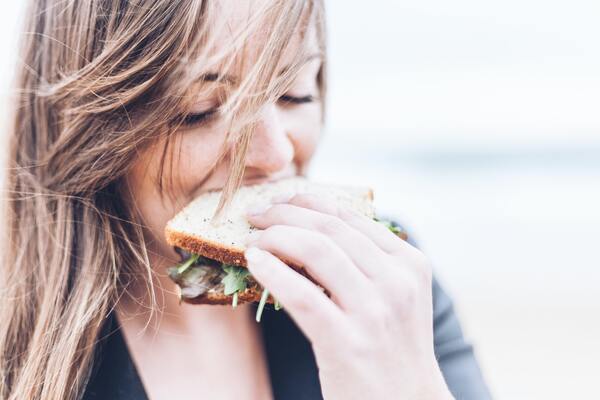
Yes, Traditional Chinese Medicine techniques such as acupuncture is effective for treating IBS symptoms. A research that evaluated the efficacy of acupuncture for the treatment of IBS through meta-analysis of randomized controlled trials provides sufficient scientific evidence to back acupuncture for IBS.
Studies have shown that acupuncture therapy for IBS works by regulating the secretion of serotonin (a chemical produced by the nerve cells that is responsible for regulating moods), and then influencing the smooth muscle movement of the digestive tract.
According to Dr. Mengfei (Devin) Yuan, most patients will have their symptoms of IBS alleviated after the first session of acupuncture treatment. They will notice that their abdomen isn’t so tense compared to before the treatment. Devin explains that acupuncture for IBS combined with moxibustion provides a more satisfying result. Regarding how many sessions for acupuncture and IBS, Dr. Mengfei explains that it will take about 10-20 sessions of acupuncture therapy for patients to see obvious changes.
Depending on the kind of IBS, Dr. Mengfei (Devin) Yuan recommends different kinds of acupuncture treatment. For IBS-C, he does not recommend moxibustion, while for Diarrhea-Predominant Irritable Bowel Syndrome, he recommends acupuncture with moxibustion, especially if you apply more tonifying manipulations.
Does Acupuncture for IBS Hurt?
Dr. Mengfei (Devin) Yuan confirms that acupuncture for IBS does not hurt. However, if you’re so anxious, you may cause the needles to move, thereby bringing you pain. What the doctor can do is to change the depth or direction of needles so that it doesn’t feel so painful.
How Fast Does Acupuncture Work for IBS?
According to Dr. Mengfei (Devin) Yuan, it takes between 20 to 30 minutes after the acupuncture needles are inserted and manipulated for you to feel the effect of acupuncture.
Can Acupuncture Make IBS Worse?
Dr. Mengfei Yuan explains that IBS will not normally hurt you. However, you may have side effects such as bleeding from the places the needles are inserted. You may feel pain too or dizziness after the acupuncture for IBS session.
Can Acupuncture Help With IBS Pain?
Yes, Dr. Mengfei Yuan agrees that most patients feel the spasm or burning pain reduced just a few minutes after needles are inserted.
Is it Better to Have Acupuncture for Anxiety at the Same Time to Treat IBS?
According to Dr. Mengfei Yuan, it is better to have acupuncture for IBS and anxiety. This is because anxiety has a close relationship with IBS; the liver qi stagnation will finally cause spleen qi deficiency. A study that aims to explore the efficacy of acupuncture for depression and anxiety in IBS supports this. If you’ve got anxiety, you should try acupressure for anxiety.
Acupressure Points for IBS
We will proceed to discuss ten acupressure points for IBS. However, the first five are the main acupressure for IBS to push when you feel the symptoms of IBS.
Acupoint: ST-25 (Other Names: Stomach-25/Tian Shu/Celestial Pivot)
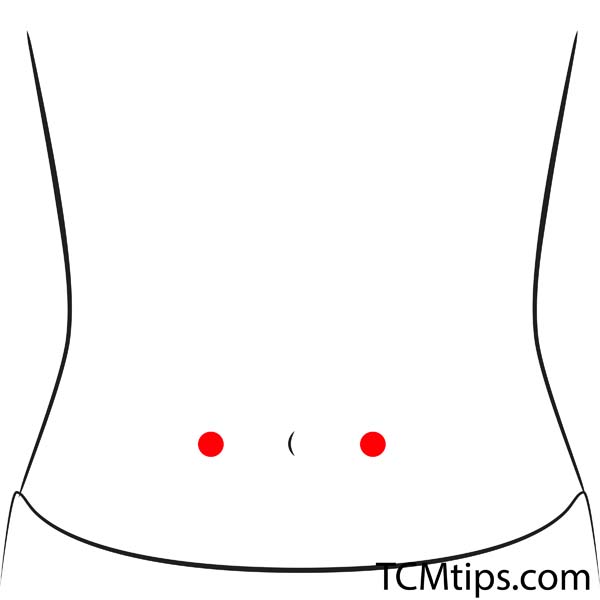
ST25, Tianshu, or Celestial Pivot should be one of the first acupressure points for IBS to come to your mind when you feel the symptoms of IBS. This pressure point is located on the stomach, three finger-width beside the belly button.
While ST25 effectively serves as acupuncture for IBS constipation, it also serves as acupressure for diarrhea. Dr. Mengfei (Devin) Yuan recommends it for the treatment of abdominal distention, borborygmus, pain around the umbilicus, dysentery, irregular menstruation, mass and gathering in the abdomen, and amenorrhea.
Acupoint: ST-36 (Other Names: Stomach-36/Zu San Li/Leg Three Miles)

The next pressure point to relieve IBS is ST-36 or Zusanli, as it is called in Chinese. This stomach meridian acupoint is located on the lower leg, four finger-width from the bulge of the tibia below the knee joint.
Dr. Mengfei (Devin) Yuan recommends St-36 for the treatment of gastric pain, vomiting, dysphagia, abdominal distention, borborygmus, diarrhea, dysentery, constipation, abdominal pain, and acute mastitis. It is also one of the pressure points for digestion.
Acupoint: Ren-12 (Other Names: The Conception Vessel-12/Zhong Wan/Middle Epigastrium)

CV-12, Ren-12 (as some literature would have it), or Zhongwan, as it is called in Chinese, is another vital acupressure for IBS. You’ll find CV12 on the stomach, five finger-width above the belly button.
While CV12 is one of the acupressure points for IBS with diarrhea. In addition, it is effective in relieving symptoms of abdominal distention, hiccup, cough, and insomnia. CV12 is also one of the pressure points for heartburn that you can easily push when you have heartburn.
Acupoint: Ren-4 (Other Names: The Conception Vessel-4/Guan Yuan/Origin Pass)
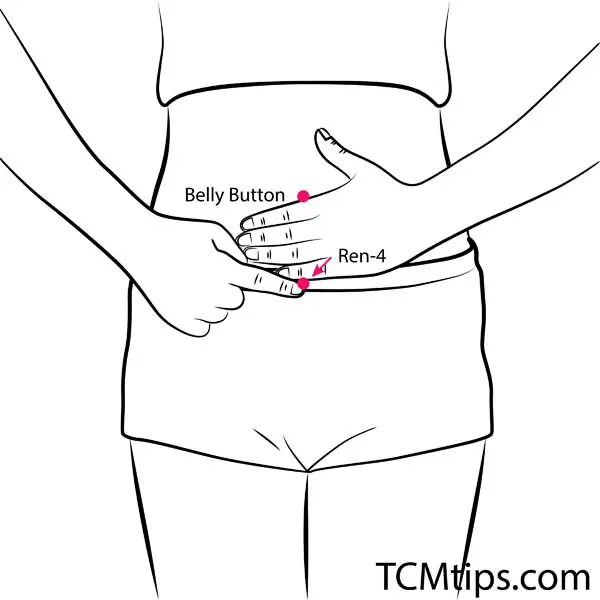
CV4, Ren-4, or Guanyuan is another of the pressure points to relieve IBS that you should know. Like CV12, it is also located on the stomach but this time four finger-width below the belly button. CV4 is responsible for strengthening and nourishing the kidney as well as calming the Shen.
CV-4 is also ideal for treating diarrhea like CV12. However, in addition to being one of the acupressure points for indigestion, it is suitable for treating issues like infertility, flaccidity of apoplexy, dyspepsia, irregular menstruation, and enuresis.
Acupoint: SP-15 (Other Names: Spleen-15/Da Heng/Great Horizontal)
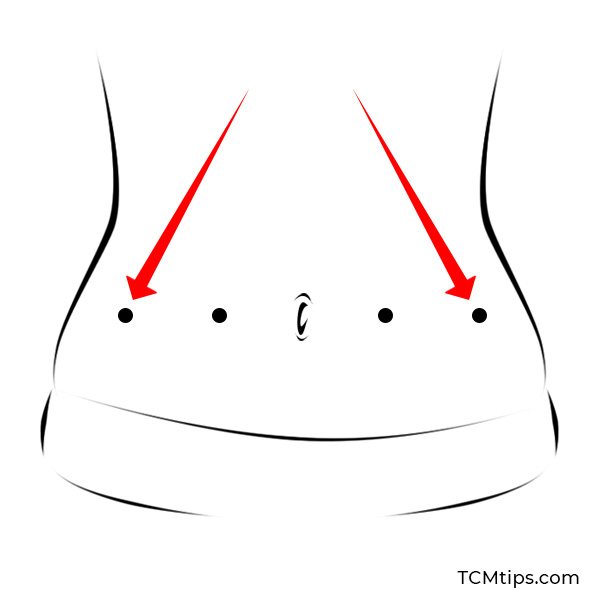
The fifth of the major acupressure points for IBS is SP15 or Daheng as it is referred to in Chinese. You’ll also find this spleen meridian acupoint on the stomach, but this time, four finger-width beside the belly button, on the same line with the nipple.
In TCM, SP15 functions to regulate the intestine and Qi and tonify the spleen. Based on these functions, SP15 is used clinically to treat abdominal pain, and diarrhea, while serving as one of the acupressure points for constipation.
Acupoint: Bl-18 (Other Names: Urinary Bladder-18/Gan Shu/Liver Transporter)

BL18 or Ganshu is another pressure point to relieve IBS. It is located on the back, about two finger-width beside the ninth thoracic vertebra of the spinous process. What BL-18 does is move stagnant liver Qi, nourish liver blood, and resolve damp-heat.
In addition to being an effective pressure point for IBS, BL-18 is one of the acupressure points for eye pain. Acupuncturists also use this pressure point to relieve pain in the hypochondrium, stop vomiting, and relieve back pain.
Acupoint: BI-20 (Other Names: Urinary Bladder-20/Pi Shu/Spleen Transporter)
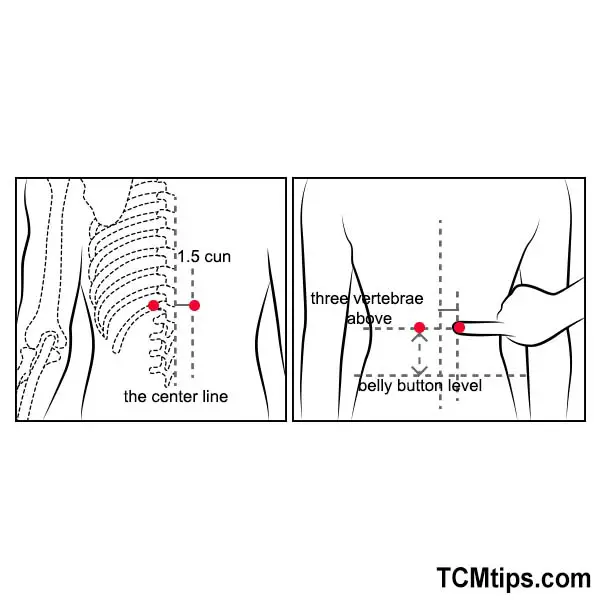
BL-20 or Pishu, is also another acupoint for digestive disorders that is located on the back. You’ll find it about two finger-width beside the eleventh thoracic vertebra of the spinous process. BL20 helps to tonify the spleen and stomach Qi and Yang and nourish the blood.
In addition to relieving the symptoms of IBS, Pishu is also used to stop vomiting, diarrhea, abdominal distention, jaundice, and dysentery. It is among the acupressure points for ovary cysts.
Acupoint: Bl-21 (Other Names: Urinary Bladder-21/Wei Shu/Stomach Transporter)

While BL-20 is called the Spleen Shu, BL-21 is called the stomach shu. It works to regulate the stomach and keep it in harmony against deficiency and excess cold or heat. Meanwhile, this acupuncture for IBS bloating is also located on the back, about two finger-width beside the twelfth thoracic vertebra.
BL21 works effectively as one of the acupressure points for stomach inflammation while it also helps to treat chest pain, borborygmus, diarrhea, nausea, and vomiting.
Acupoint: Bl-25 (Other Names: Urinary Bladder-25/Da Chang/Large Intestine Transporter)

BL25, like the other bladder meridian acupoints, is a Shu, only this time for the intestine. It works to regulate the intestine and strengthen the lumbar region and legs based on its location. BL25 is located about two finger-width beside the spine at the junction of the fourth and fifth lumbar vertebra.
Based on its function and location, this acupressure point for IBS is ideal for relieving the symptoms of borborygmus, abdominal distension, diarrhea, constipation, and muscular atrophy. It serves as acupressure for stomach pain in children.
Acupoint: Liv-3 (Other Names: Liver-3/Tai Chong/Supreme Rush)

Finally, the last pressure point that serves as acupressure for IBS is Liv-3 or Taichong. This popular liver meridian acupoint is located on the top of the foot, in the depression above the web of the great toe and the first toe.
Liv-3 is responsible for regulating the liver Qi, subduing the Liver Yang, and calming the Shen. It is one of the acupressure points for liver detox as well as the right pressure point to push for issues like headache, eye pain, wry face, abdominal distention, hiccup, and infantile convulsion.
Conclusion
Irritable Bowel Syndrome is a long-term gastrointestinal disorder that has no cure, which makes acupressure and acupuncture therapy a better treatment option. The acupressure points to press for IBS symptoms include:
- ST-25 – effective for IBS that is constipation dominant
- ST-36 – effective in treating gastric pain, diarrhea, and constipation
- Ren-12 – Effective for IBS that is diarrhea dominant
- Ren-4 – Strengthens and nourishes the kidney.
- SP-15 – regulates the intestine and Qi and tonify the spleen
- BL-18 – moves stagnant liver Qi, nourishes liver blood, and resolves damp-heat
- BL-20 – tonifies the spleen and stomach Qi and Yang.
- BL-21 – regulates the stomach and keeps it in harmony.
- BL-25 – regulates the intestine
- Liv-3 – regulates the liver Qi, subdues the Liver Yang, and calm

Try our Anti-Aging Gua Sha Tool designed to bring out your skin’s natural glow.
Best Gua Sha Product- Anti-Aging: The tool is designed to target 11 specific aging signs such as wrinkles and sagging skin. By following the 7-step routine, users can improve skin firmness and reduce fine lines naturally.
- Enhances Skincare Routine: It works effectively with serums and lotions, boosting absorption and efficacy of skincare products.
- Visible Skin Improvement: Users can expect a smoother complexion, reduced puffiness, and a more youthful appearance.
 P. Sze
P. Sze 